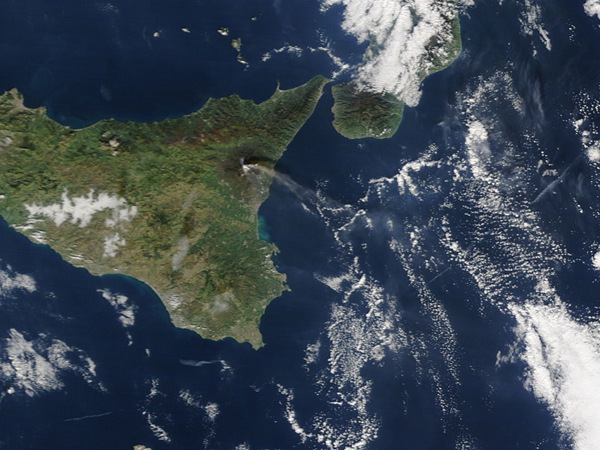Images
December 17, 2015 - Plume from Mt. Etna in Sicily
Tweet
The Moderate Resolution Imaging Spectroradiometer (MODIS) aboard NASA’s Terra satellite passed over Mt. Etna on December 8, 2015, and captured a true-color image of the volcano’s ongoing eruption. A large plume of ash and gas rises from the dark basaltic volcano and drifts to the southeast.
Sicily’s Mount Etna is one of the most consistently active volcanoes in the world, with a historical record of eruptions dating back to 1500 BC. The surface of the volcano consists of thick, dark basaltic lava flows that extend outward from the summit craters and down its flanks.
The current eruptive phase began on December 2 when, after a two-year period of relative quiescence, Mt. Etna’s Voragine crater began to show increasing signs of life, spewing jets of hot material as high as 3 kilometers above the summit. Over the next several days Voragine had several paroxysms of spectacular eruption, but by December 12 the volcano was reported to be resting more-or-less quietly once again.
Image Facts
Satellite:
Terra
Date Acquired: 12/8/2015
Resolutions:
1km ( B), 500m (139.3 KB), 250m (320 KB)
Bands Used: 1,4,3
Image Credit:
Jeff Schmaltz, MODIS Land Rapid Response Team, NASA GSFC
Tweet
The Moderate Resolution Imaging Spectroradiometer (MODIS) aboard NASA’s Terra satellite passed over Mt. Etna on December 8, 2015, and captured a true-color image of the volcano’s ongoing eruption. A large plume of ash and gas rises from the dark basaltic volcano and drifts to the southeast.
Sicily’s Mount Etna is one of the most consistently active volcanoes in the world, with a historical record of eruptions dating back to 1500 BC. The surface of the volcano consists of thick, dark basaltic lava flows that extend outward from the summit craters and down its flanks.
The current eruptive phase began on December 2 when, after a two-year period of relative quiescence, Mt. Etna’s Voragine crater began to show increasing signs of life, spewing jets of hot material as high as 3 kilometers above the summit. Over the next several days Voragine had several paroxysms of spectacular eruption, but by December 12 the volcano was reported to be resting more-or-less quietly once again.
Image Facts
Satellite:
Terra
Date Acquired: 12/8/2015
Resolutions:
1km ( B), 500m (139.3 KB), 250m (320 KB)
Bands Used: 1,4,3
Image Credit:
Jeff Schmaltz, MODIS Land Rapid Response Team, NASA GSFC




